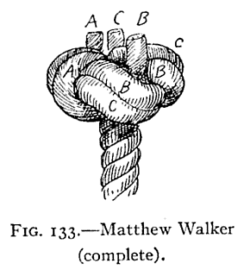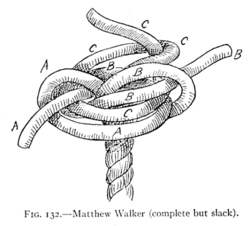m (- Category of AYHAB) |
|||
| (17 intermediate revisions by 4 users not shown) | |||
| Line 1: | Line 1: | ||
| − | + | <noinclude><translate><!--T:2--> | |
| + | </noinclude> | ||
| − | + | <!--T:3--> | |
| + | {{ | ||
| − | == | + | <!--T:4--> |
| + | Knot | ||
| + | | name=Matthew Walker knot | ||
| + | | image= Matthew Walker knot.gif | ||
| + | | image2 = Matthew Walker knot-slack.gif | ||
| + | | use = A '''Matthew Walker knot''' is a decorative knot that is used to keep the end of a rope from fraying. It is tied by unraveling the strands of a twisted rope, knotting the strands together, then laying up the strands together again. It may also be tied using several separate cords, in which case it keeps the cords together in a bundle. | ||
| − | A Matthew Walker knot is tied in a circular bundle of any number of strands. | + | <!--T:5--> |
| + | | tying_instructions = | ||
| + | A Matthew Walker knot is tied in a circular bundle of any number of strands. To tie the knot, the tier takes each strand and forms a loop around the rest of the bundle, then passes the end through the newly-formed loop to form an overhand knot. He then moves to the next strand over, moving around the bundle in the direction he passes the loops. Tying the first strand around the bundle is straightforward, but each subsequent end must be passed through the previously-formed loops in order to contain all of the other strands in its loop. When tightening, it may help to roll the knot along the bundle, especially when using only two strands. The final effect is a spiral knot vaguely resembling a section of a barber's pole. | ||
| − | + | <!--T:6--> | |
| − | + | }} | |
| − | + | <noinclude></translate></noinclude> | |
| − | |||
| − | |||
Latest revision as of 02:52, 15 July 2022
| Matthew Walker knot |
|---|
|
Use: A Matthew Walker knot is a decorative knot that is used to keep the end of a rope from fraying. It is tied by unraveling the strands of a twisted rope, knotting the strands together, then laying up the strands together again. It may also be tied using several separate cords, in which case it keeps the cords together in a bundle.
How to tie:
|


